I remember my first attempt at keeping houseplants alive.Let’s just say it didn’t end well for my poor spider plant!
But after years of trial and error, I have discovered that becoming a successful plant parent isn’t about having a natural “green thumb,” it’s about choosing the right plants to start with.
If you’re new to the world of indoor plants, I’m here to help you avoid my early mistakes.
In this post, I will share my top 10 picks for indoor plant beginners that are surprisingly hard to kill, even if you’ve never cared for a plant before.
These resilient beauties will forgive your occasional neglect and bring life to your space without demanding too much of your time or expertise.
1. Snake Plant (Sansevieria trifasciata)
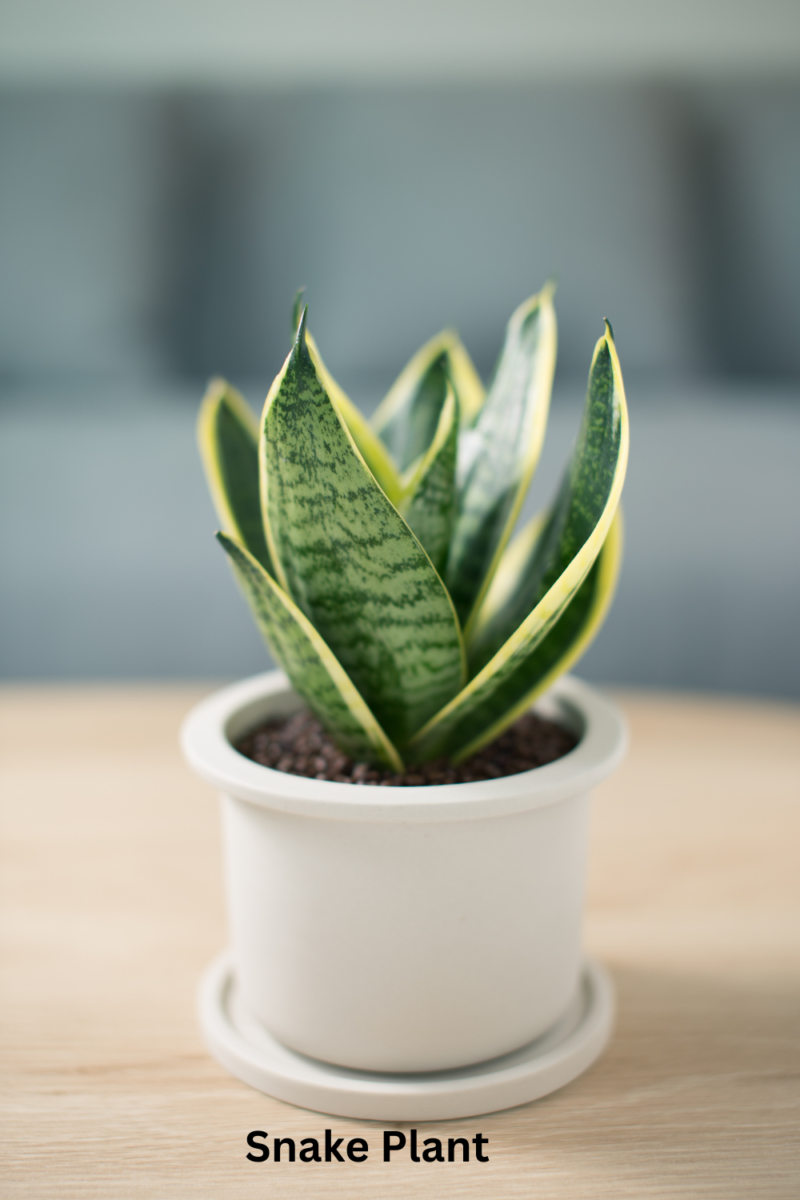
Snake Plant
The Snake Plant is my absolute go-to recommendation for anyone who claims they can’t keep plants alive.
This resilient beauty thrives on neglect, making it perfect for forgetful waterers or busy individuals.
With its striking upright leaves and architectural shape, it adds a modern touch to any room.
Why Snake Plants Are Perfect for Beginners
Light Requirements
Snake plants are incredibly adaptable when it comes to light.They can survive in low light conditions but will grow faster in bright, indirect light.However, they can tolerate direct sunlight for a few hours each day, making them versatile for almost any spot in your home.
Watering Needs
This is where snake plants truly shine for beginners. They prefer to dry out completely between waterings. During winter, you might only need to water once a month! Overwatering is the quickest way to kill a snake plant, so when in doubt, hold off on watering.
Temperature & Humidity
Snake plants thrive in normal household temperatures between 60-85°F. They don’t require any special humidity considerations, making them perfect for any room in your home, including bedrooms and offices.
Soil & Fertilizing
Use a well-draining cactus or succulent soil mix. Snake plants don’t need much fertilizer – feeding them once in spring and once in summer with a general houseplant fertilizer is plenty.
Pro Tip: Snake plants are excellent air purifiers, removing toxins like formaldehyde and benzene from your home. They’re also one of the few plants that convert CO2 to oxygen at night, making them ideal bedroom companions.
2. Pothos (Epipremnum aureum)
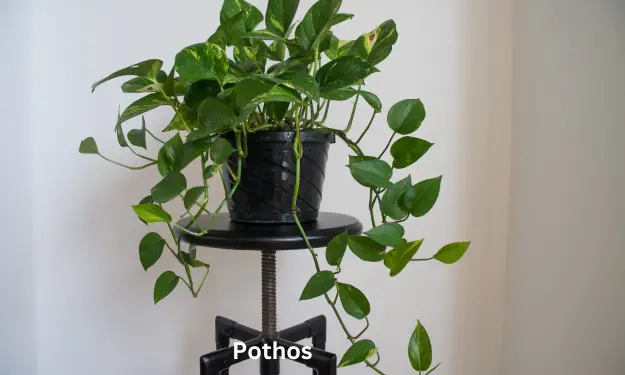
Pothos is my personal favorite for anyone starting their plant journey because it practically tells you when it needs water by visibly drooping.
But don’t worry, it perks right back up after watering!
This trailing plant comes in various patterns and colors, from the classic golden pothos to marble queen and neon varieties.
Why Pothos Are Perfect for Beginners
Light Requirements
Pothos adapts to a wide range of light conditions, from low light to bright indirect light. However, they grow faster and develop more variegation in brighter spots. Just avoid direct sunlight, which can burn the leaves.
Watering Needs
Wait until the top 1-2 inches of soil feel dry before watering. Pothos will dramatically droop when thirsty, making it obvious when they need a drink. This visual cue is perfect for beginners learning to read their plants’ needs.
Temperature & Humidity
Pothos thrive in normal room temperatures between 65-85°F. They don’t require special humidity but will appreciate an occasional misting, especially in dry environments.
Soil & Fertilizing
A standard potting mix works well. Feed with a balanced houseplant fertilizer every 2-3 months during the growing season (spring through fall).
Pro Tip: Pothos are incredibly easy to propagate! Simply cut a stem below a node (the bumpy part where leaves emerge), place it in water, and watch roots develop in a few weeks. This means one plant can become many – perfect for expanding your collection or sharing with friends.
3. ZZ Plant (Zamioculcas zamiifolia)

ZZ Plant
I often joke that the ZZ plant is practically indestructible.
With its glossy, dark green leaves and upright growth habit, this plant not only looks sophisticated but can survive weeks of neglect.
Because of its extreme drought tolerance, the ZZ plant has earned its reputation as one of the easiest houseplants for beginners.
Why ZZ Plants Are Perfect for Beginners
Light Requirements
ZZ plants can survive in low light conditions, though they grow best in medium to bright indirect light. They can even thrive under fluorescent lights, making them perfect for offices and other spaces without natural light.
Watering Needs
Thanks to their thick rhizomes that store water, ZZ plants are extremely drought-tolerant. Water only when the soil is completely dry – usually every 2-3 weeks, or even less frequently in winter. Overwatering is the main way to harm this hardy plant.
Temperature & Humidity
ZZ plants prefer temperatures between 65-85°F but can tolerate a wider range. They don’t require any special humidity considerations and do fine in dry environments.
Soil & Fertilizing
Use a well-draining potting mix. ZZ plants are not heavy feeders – fertilize lightly once or twice a year in spring and summer with a balanced houseplant fertilizer.
Pro Tip: Look for the newer ‘Raven’ ZZ plant variety with dramatic black-purple foliage that adds a striking contrast to your plant collection. Just be aware that all parts of ZZ plants contain calcium oxalate crystals, which can cause irritation if ingested, so keep away from pets and children.
4. Spider Plant (Chlorophytum comosum)
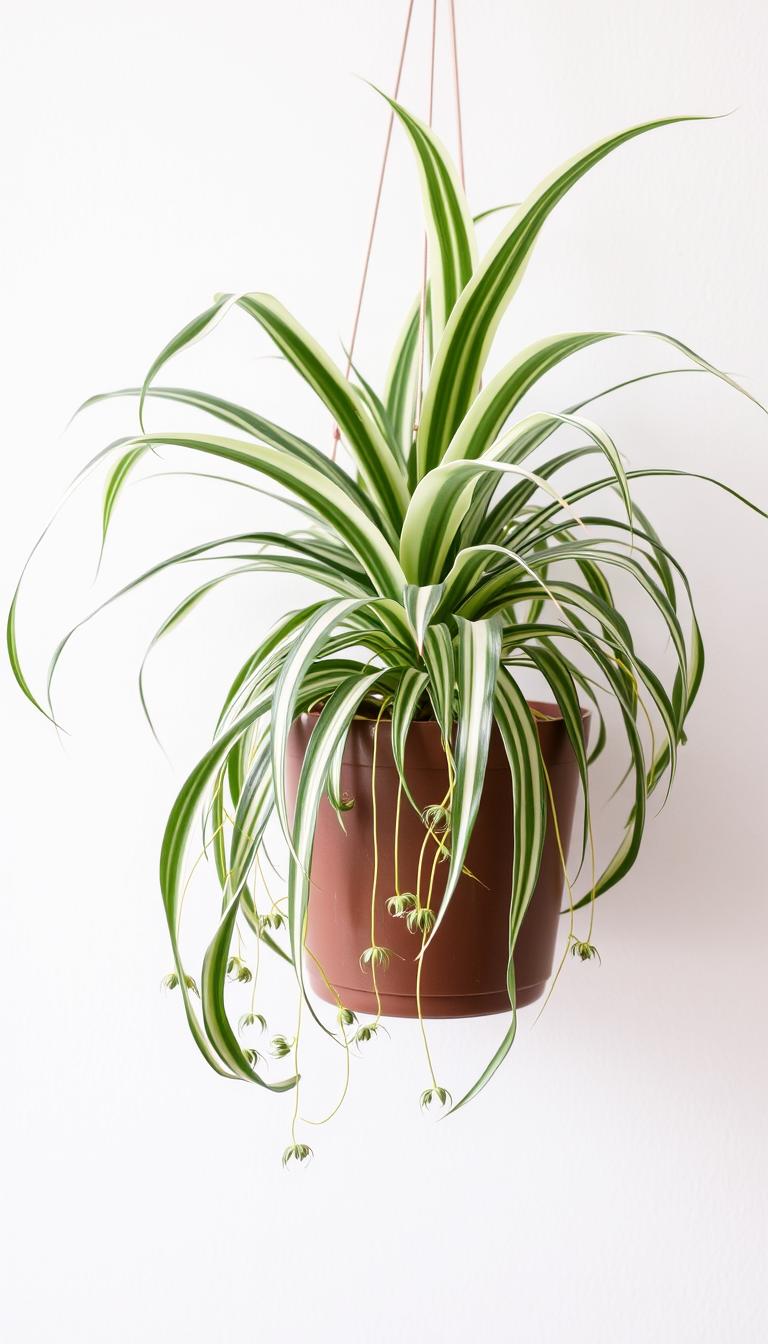
Spider plants were my first successful houseplants, and I still love them for their forgiving nature and the way they produce adorable “babies” (plantlets) on long stems.
These fast-growing plants are perfect for beginners because they clearly communicate their needs and bounce back quickly from occasional neglect.
Why Spider Plants Are Perfect for Beginners
Light Requirements
Spider plants prefer bright, indirect light but can tolerate lower light conditions. Too much direct sun can scorch their leaves, so a few feet away from a window is ideal. Their adaptability makes them suitable for various spots in your home.
Watering Needs
Allow the soil to dry out slightly between waterings. Spider plants will tell you when they’re thirsty – their normally perky leaves will start to look a bit droopy. They’re also somewhat tolerant of fluoride and chlorine in tap water, unlike many houseplants.
Temperature & Humidity
These plants thrive in normal room temperatures between 65-75°F. They appreciate higher humidity but adapt well to average household conditions.
Soil & Fertilizing
A standard, well-draining potting mix works well. Feed with a balanced houseplant fertilizer every 2-3 months during the growing season (spring through fall).
Pro Tip: Spider plants are among the most pet-friendly houseplants, making them a safe choice for homes with curious cats and dogs. The plantlets they produce can be easily rooted in water or soil to create new plants – a fun way to expand your collection or share with friends!
5. Rubber Plant (Ficus elastica)

The Rubber Plant has become one of my favorite statement plants because of its dramatic, glossy leaves and relatively easy care requirements.
Available in green, burgundy, and variegated varieties, this plant adds a bold, tropical touch to any room while being surprisingly forgiving for beginners.
Why Rubber Plants Are Perfect for Beginners
Light Requirements
Rubber plants prefer bright, indirect light but can adapt to medium light conditions. In lower light, they’ll grow more slowly and may lose some of their vibrant coloration. Avoid direct sunlight, which can scorch the leaves.
Watering Needs
Allow the top 1-2 inches of soil to dry out between waterings. Rubber plants prefer consistent moisture but are somewhat drought-tolerant. They need less water in winter when growth slows down.
Temperature & Humidity
These tropical plants prefer temperatures between 65-85°F and appreciate humidity, though they adapt to average household conditions. Avoid cold drafts and sudden temperature changes.
Soil & Fertilizing
Use a well-draining potting mix with some peat moss. Feed with a balanced houseplant fertilizer diluted to half strength every month during the growing season (spring through fall).
Pro Tip: Rubber plants can grow quite tall (up to 10 feet indoors!), but you can control their height by pruning. The cut stems can be propagated in water or soil to create new plants. Just be aware that the milky sap can cause skin irritation in some people, so wear gloves when pruning.
6. Chinese Evergreen (Aglaonema)

Chinese Evergreens have become increasingly popular, and for good reason!
These stunning plants come in a variety of leaf patterns and colors, from classic green to pink and silver variegation.
I love recommending them to beginners because they’re both beautiful and forgiving, thriving even in challenging low-light conditions.
Why Chinese Evergreens Are Perfect for Beginners
Light Requirements
Chinese Evergreens are champions of low light tolerance, though varieties with more color and variegation will need medium to bright indirect light to maintain their patterns. They’re perfect for those darker corners where other plants struggle.
Watering Needs
Allow the top inch of soil to dry out between waterings. These plants prefer consistent moisture but can tolerate occasional drought. Reduce watering in winter when growth slows down.
Temperature & Humidity
Chinese Evergreens prefer warm temperatures between 65-80°F and moderate to high humidity. However, they adapt well to average household conditions. Avoid temperatures below 60°F and cold drafts.
Soil & Fertilizing
Use a well-draining potting mix with some peat moss. Feed with a balanced houseplant fertilizer diluted to half strength every 2-3 months during the growing season.
Pro Tip: Chinese Evergreens grow more compact and bushy than many other houseplants, making them perfect for tabletops, shelves, and other small spaces. The newer varieties with pink and red coloration can add a pop of color to your plant collection without requiring the bright light that most colorful plants need.
7. Peace Lily (Spathiphyllum)

Peace Lilies have been popular houseplants for decades because they’re one of the few flowering plants that thrive in low light.
I recommend them to beginners because they dramatically droop when thirsty, making it obvious when they need water, and they quickly perk back up after watering.
Why Peace Lilies Are Perfect for Beginners
Light Requirements
Peace Lilies can grow in low to medium light, though they’ll produce more of their distinctive white “flowers” (actually modified leaves called spathes) in brighter indirect light.
They can even thrive under fluorescent lights, making them perfect for offices.
Watering Needs
Peace Lilies like consistently moist but not soggy soil. They’ll tell you when they need water by drooping dramatically, but try not to let them get to this point too often, as it can stress the plant. They’re sensitive to chlorine and fluoride, so using filtered water is best.
Temperature & Humidity
These tropical plants prefer temperatures between 65-85°F and higher humidity. They’ll adapt to average household conditions but will appreciate regular misting or placement on a pebble tray with water.
Soil & Fertilizing
Use a well-draining potting mix rich in organic matter. Feed with a balanced houseplant fertilizer diluted to half strength every 6-8 weeks during the growing season.
Pro Tip: Peace Lilies are excellent air purifiers, removing toxins like benzene, formaldehyde, and trichloroethylene from your home. However, they are toxic to cats and dogs if ingested, so keep them out of reach of curious pets.
8. Heartleaf Philodendron (Philodendron hederaceum)
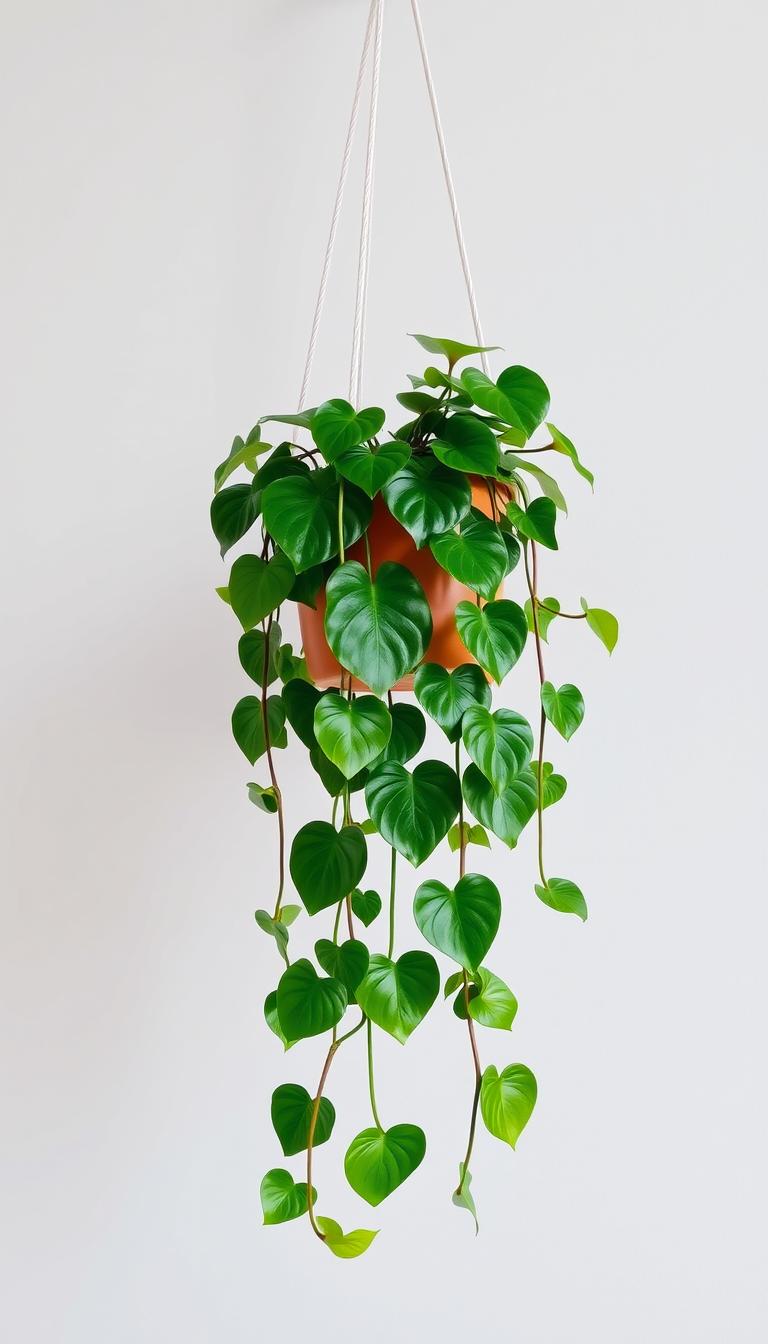
Heartleaf Philodendrons have been beloved houseplants for generations, and I can see why!
These trailing plants with their perfectly heart-shaped leaves are not only charming but nearly impossible to kill.
They’re perfect for beginners who want a plant that grows quickly and forgives occasional neglect.
Why Heartleaf Philodendrons Are Perfect for Beginners
Light Requirements
Heartleaf Philodendrons are incredibly adaptable to different light conditions, from low to bright indirect light. They’ll grow faster and have larger leaves in brighter spots but will survive in dimmer locations too. Avoid direct sunlight, which can burn the leaves.
Watering Needs
Allow the top inch of soil to dry out between waterings. These plants prefer consistent moisture but can bounce back from occasional drought. They’ll tell you they’re thirsty when their leaves start to droop slightly.
Temperature & Humidity
Philodendrons thrive in normal room temperatures between 65-80°F. They appreciate higher humidity but adapt well to average household conditions.
Soil & Fertilizing
A standard, well-draining potting mix works well. Feed with a balanced houseplant fertilizer every 2-3 months during the growing season (spring through fall).
Pro Tip: Heartleaf Philodendrons are perfect for hanging baskets or placing on high shelves where their vines can cascade down. They’re also incredibly easy to propagate – simply cut a stem with a node, place it in water, and watch roots develop within weeks.
9. Jade Plant (Crassula ovata)
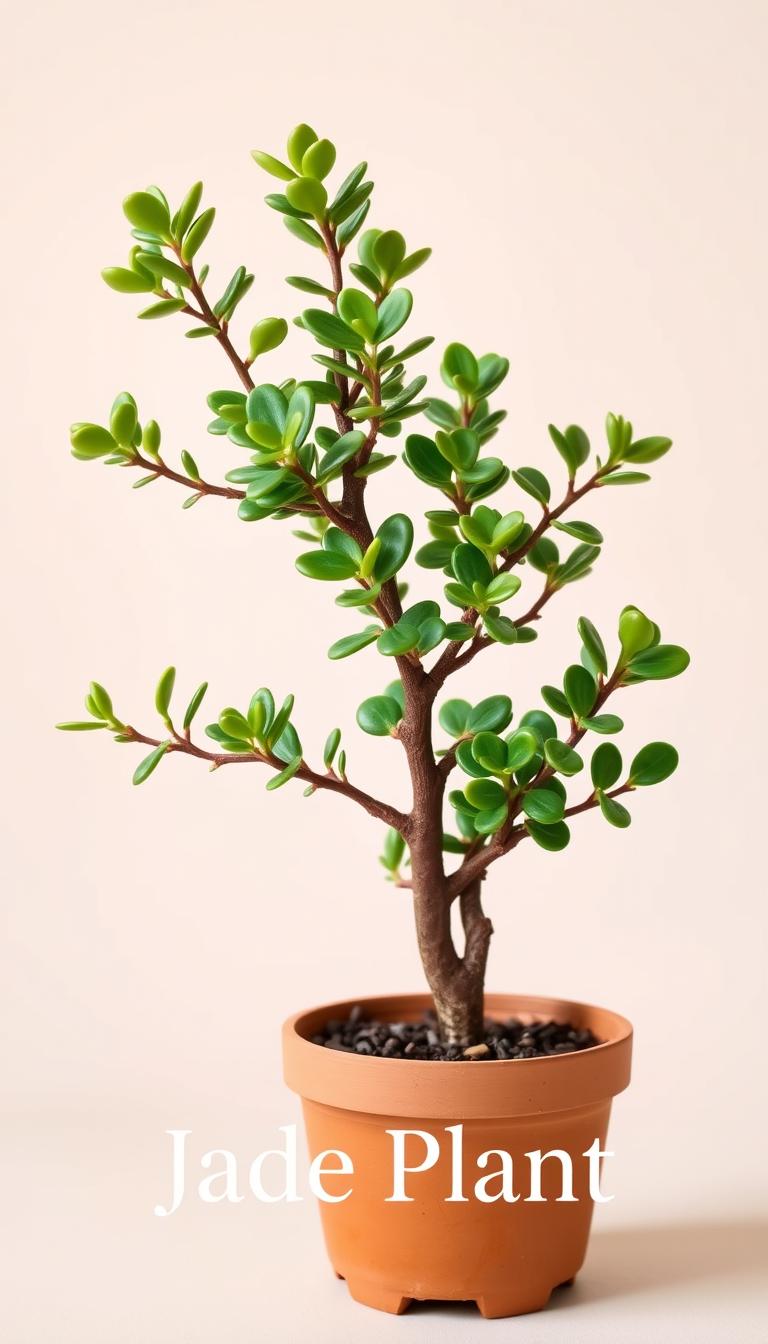
Jade Plants hold a special place in my heart because they can live for decades, becoming family heirlooms passed down through generations.
These succulent plants with their thick, glossy leaves have a tree-like appearance that adds character to any space, and their minimal care requirements make them perfect for beginners.
Why Jade Plants Are Perfect for Beginners
Light Requirements
Jade Plants need bright light to thrive, with at least 4 hours of direct sunlight daily being ideal. A south or west-facing window is perfect. Without enough light, they become leggy and weak.
Watering Needs
As succulents, Jade Plants store water in their leaves and stems. Allow the soil to dry completely between waterings – typically every 2-3 weeks, and even less frequently in winter. Overwatering is the quickest way to kill a Jade Plant.
Temperature & Humidity
Jade Plants prefer temperatures between 65-75°F during the day and slightly cooler at night. They do well in dry environments and don’t require any special humidity considerations.
Soil & Fertilizing
Use a well-draining cactus or succulent soil mix. Feed sparingly with a balanced houseplant fertilizer diluted to half strength once every 2-3 months during the growing season.
Pro Tip: In many cultures, Jade Plants are considered symbols of prosperity and good luck, making them popular housewarming gifts. With proper care, they can grow into impressive miniature tree-like structures over time, developing thick trunks and branches.
10. Monstera (Monstera deliciosa)
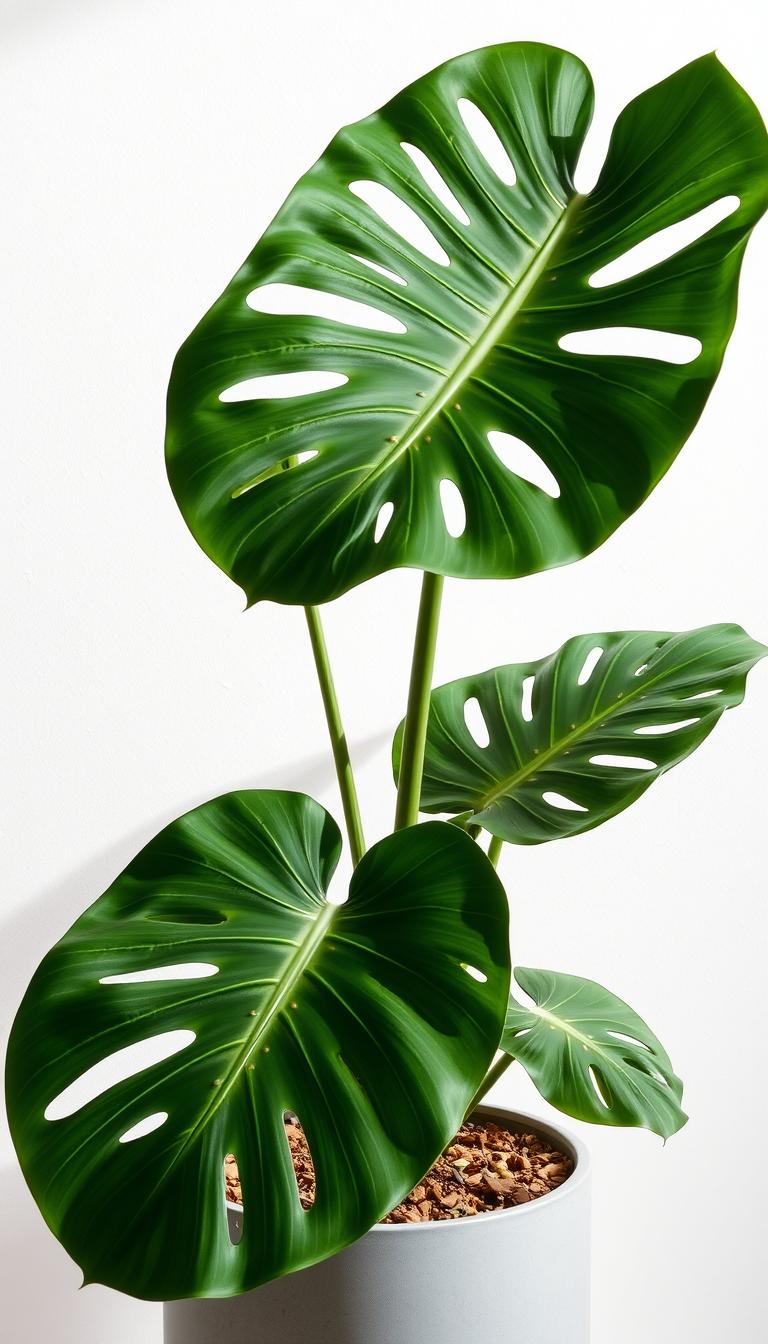
I’ve saved one of my absolute favorites for last! The Monstera, also known as the Swiss Cheese Plant, has become an Instagram star in recent years thanks to its dramatic, holey leaves.
Despite its exotic appearance, it’s surprisingly easy to care for, making it perfect for beginners who want a statement plant with minimal fuss.
Why Monsteras Are Perfect for Beginners
Light Requirements
Monsteras prefer bright, indirect light but can tolerate medium light conditions. Too little light will result in smaller leaves with fewer holes, while direct sunlight can burn the leaves. A few feet away from a window with filtered light is ideal.
Watering Needs
Allow the top 1-2 inches of soil to dry out between waterings. Monsteras prefer consistent moisture but can tolerate occasional drought. They need less water in winter when growth slows down.
Temperature & Humidity
These tropical plants prefer temperatures between 65-85°F and appreciate higher humidity, though they adapt well to average household conditions. They’ll grow faster and develop more dramatic leaf fenestrations (holes) in higher humidity.
Soil & Fertilizing
Use a well-draining potting mix rich in organic matter. Feed with a balanced houseplant fertilizer every month during the growing season (spring through fall).
Pro Tip: Young Monstera plants have solid, heart-shaped leaves. The characteristic splits and holes develop as the plant matures – a process called fenestration. To encourage larger leaves with more dramatic holes, provide bright indirect light, consistent watering, and support for climbing (like a moss pole).
Quick Reference: Indoor Plant Care Summary
| Plant | Light Needs | Water Frequency | Difficulty Level | Pet-Friendly |
| Snake Plant | Low to Bright Indirect | Every 3-4 weeks | Very Easy | No |
| Pothos | Low to Bright Indirect | Every 1-2 weeks | Very Easy | No |
| ZZ Plant | Low to Bright Indirect | Every 2-3 weeks | Very Easy | No |
| Spider Plant | Medium to Bright Indirect | Every 1-2 weeks | Easy | Yes |
| Rubber Plant | Medium to Bright Indirect | Every 1-2 weeks | Easy | No |
| Chinese Evergreen | Low to Medium | Every 1-2 weeks | Easy | No |
| Peace Lily | Low to Medium | Every 1-2 weeks | Easy | No |
| Heartleaf Philodendron | Low to Bright Indirect | Every 1-2 weeks | Very Easy | No |
| Jade Plant | Bright, Some Direct Sun | Every 2-3 weeks | Easy | No |
| Monstera | Medium to Bright Indirect | Every 1-2 weeks | Easy | No |
Common Mistakes Indoor Plant Beginners Should Avoid
Overwatering
This is by far the most common way beginners kill their plants. More houseplants die from too much water than too little.
Always check the soil moisture before watering, and remember that most plants need less water in winter when growth slows down.
Ignoring Light Requirements
Even “low light” plants need some light to survive.
No plant can live in a completely dark room. If your space has limited natural light, consider supplementing with grow lights or choosing plants specifically adapted to lower light conditions.
Frequent Repotting
Many plants actually prefer to be somewhat root-bound and don’t need frequent repotting. Most houseplants only need to be repotted every 1-2 years, and some even less frequently. Only repot when you see roots growing out of the drainage holes.
Inconsistent Care
Plants thrive on consistency. Try to establish a regular watering routine and keep plants in stable conditions without frequent moving or dramatic temperature changes. This is especially important for more sensitive plants.
Final Thoughts on Starting Your Indoor Plant Journey
I hope this guide has shown you that becoming a successful plant parent doesn’t require any special talent, just the right plants and a bit of basic knowledge.
Each of these 10 plants offers a forgiving introduction to the world of indoor gardening.
Start with one or two that catch your eye and match your living conditions, then gradually expand your collection as your confidence grows.
Remember that every plant parent makes mistakes, and that’s okay!
Plants are resilient, and most will bounce back from occasional neglect or overcare.
The joy of watching a plant thrive under your care is well worth the learning curve.
Before you know it, you’ll be the one giving plant advice to your friends!
Happy planting!




